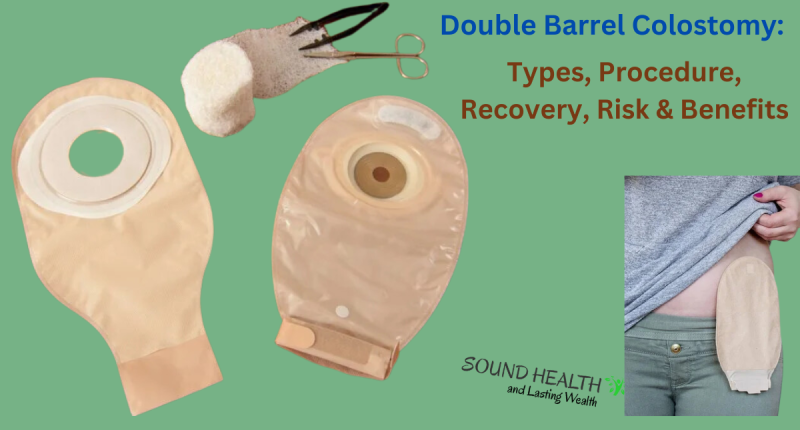A double-barrel colostomy is a type of ostomy surgery that creates two openings in the abdomen, called stomas. These stomas are connected to the colon, which is the large intestine. The purpose of a double-barrel colostomy is to divert stool from the colon to the outside of the body. This may be necessary for a variety of reasons, including:
- Bowel obstruction: A blockage in the colon that prevents stool from passing through.
- Bowel perforation: A hole in the colon that allows stool to leak into the abdominal cavity.
- Bowel cancer: Surgery to remove a section of the colon that contains cancer.
- Inflammatory bowel disease (IBD): Chronic inflammation of the colon, such as Crohn’s disease or ulcerative colitis.
In a double-barrel colostomy, the colon is divided into two sections. The proximal end of the colon, which is the end closest to the stomach, is brought out to the surface of the abdomen to create a stoma called the proximal stoma. The distal end of the colon, which is the end closest to the rectum, is also brought out to the surface of the abdomen to create a stoma called the distal stoma.
The proximal stoma typically passes formed stool, while the distal stoma passes mucus. However, in some cases, both stomas may pass both stool and mucus.
Types of double-barrel colostomy
There are two main types of double-barrel colostomy:
Hartmann’s procedure: This is the most common type of double-barrel colostomy. In this procedure, the surgeon separates the colon and brings both ends out through the abdominal wall. The proximal end of the colon is usually brought out first and is functional, while the distal end of the colon is typically closed off. Hartmann’s procedure is often used as a temporary measure to allow the colon to heal after surgery.
Double-barrel colostomy with double stomas: In this procedure, both ends of the colon are brought out through the abdominal wall and are both functional. This type of colostomy is typically used as a permanent measure when there is a need to divert stool from both ends of the colon.
The type of double-barrel colostomy that is right for you will depend on your individual circumstances. Your surgeon will discuss the options with you and help you make the best decision for your health.
Procedure Steps
The specific steps of a double-barrel colostomy procedure will vary depending on the individual patient’s circumstances. However, the general steps are as follows:
Anesthesia: The patient will be given general anesthesia to numb their body and prevent them from feeling pain during the surgery.
Incision: The surgeon will make an incision in the abdomen, typically in the lower right quadrant.
Location of the colon: The surgeon will locate the affected portion of the colon.
Separation of the colon: The surgeon will separate the colon into two sections.
Creation of stomas: The surgeon will create two openings in the abdominal wall, called stomas.
Bringing the colon ends to the stomas: The surgeon will bring the two ends of the colon out through the stomas.
Securing the colon: The surgeon will secure the colon to the skin around the stomas.
Closing the incision: The surgeon will close the incision with stitches or staples.
Recovery
Recovery from a double-barrel colostomy typically involves several steps and can take several weeks or months to fully complete. The initial recovery period, which usually lasts for 4-6 weeks, focuses on wound healing, managing the stoma, and adjusting to the new digestive system. During this time, you may experience some discomfort and pain, which can be managed with medications prescribed by your doctor.
Immediate Post-Operative Care – In the hospital, you will receive regular care from nurses to monitor your wound healing, bowel function, and overall health. You will also be taught how to care for your stoma, including how to empty and change your ostomy appliance.
Early Recovery Phase (4-6 Weeks) – During this phase, you will continue to heal and focus on adjusting to your new lifestyle with a colostomy. You will learn how to manage your diet to maintain regular bowel movements and prevent complications like constipation or diarrhea. Your doctor may also recommend physical therapy to help you strengthen your abdominal muscles and regain normal movement.
Sustained Recovery (3-6 Months) – As you progress through recovery, you will gain more confidence and experience in managing your colostomy. You will also start to incorporate more physical activity into your routine. Regular follow-up appointments with your doctor will ensure that your stoma is healthy and that you are managing your bowel function effectively.
ALSO READ: What Happens To Your Anus After Colostomy?
Potential Risk Complications
While most people with a double-barrel colostomy have a smooth recovery, some complications may arise. These include:
Infection: Infection at the stoma site is a common concern in the early stages of recovery. Prompt treatment with antibiotics is usually effective.
Stoma prolapse: Stoma prolapse occurs when the stoma bulges out of the abdominal wall. This can cause discomfort, pain, and difficulty emptying the stoma. Treatment may involve manual reduction or surgical correction.
Parastomal hernia: A parastomal hernia occurs when a portion of the bowel or abdominal fat protrudes through the weakened area around the stoma. This can lead to pain, herniation of stool, and infection. Surgery is often required to repair the hernia.
Blockage: A stoma blockage occurs when stool cannot pass through the stoma. This can cause severe pain, bloating, and nausea. Treatment may involve manual disimpaction, dietary changes, or surgery.
Dehydration and electrolyte imbalance: Because a double-barrel colostomy diverts stool away from the normal absorption process, people with this type of colostomy are at risk of dehydration and electrolyte imbalance. This is especially true in the first few weeks after surgery, when the body is still adjusting to the new digestive system.
Skin irritation: The skin around the stoma can become irritated due to the constant contact with stool and ostomy appliances. This can lead to discomfort, itching, and infection.
Psychological distress: A double-barrel colostomy can be a major life change, and it is not uncommon for people to experience psychological distress after surgery. This can include anxiety, depression, and social isolation.
Benefits
Aside from the aforementioned complications associated with double-barrel colostomy, it has some amazing health benefits that often outweigh the risks, and most people with a double-barrel colostomy can live normal, active lives. These benefits include:
Provides a temporary solution to allow the colon to heal: If the colon is damaged or diseased, a double-barrel colostomy can provide a temporary diversion of stool, allowing the colon to heal. This can be helpful for conditions such as ulcerative colitis, Crohn’s disease, and trauma to the colon.
Allows for more control over bowel movements: With a double-barrel colostomy, you have more control over when and how often you have bowel movements. This can be helpful for people who experience frequent or unpredictable bowel movements.
Reduces the risk of infection: By diverting stool away from the rectum, a double-barrel colostomy can reduce the risk of infection in the rectum and anus. This can be especially beneficial for people who have a history of rectal problems.
Provides a more natural way to pass stool: With a double-barrel colostomy, you can pass stool through the rectum and anus, which is more natural than using an ostomy appliance. This can be psychologically beneficial for some people.
Allows for a more active lifestyle: With proper care and management, most people with a double-barrel colostomy can live active and fulfilling lives. They can participate in sports, travel, and enjoy their hobbies without limitations.
Overall, a double-barrel colostomy can be a life-saving procedure that provides many benefits for people with severe colon problems.
Here are some of the specific benefits of double-barrel colostomy for different conditions:
Ulcerative colitis: A double-barrel colostomy can provide a temporary or permanent solution for ulcerative colitis, allowing the colon to heal and reducing the risk of complications such as perforation and bleeding.
Crohn’s disease: A double-barrel colostomy can be a temporary or permanent solution for Crohn’s disease, allowing the colon to heal and reducing the risk of complications such as obstruction, fistulas, and abscesses.
Trauma to the colon: A double-barrel colostomy can be used to temporarily divert stool from the colon after trauma, allowing the colon to heal and reduce the risk of infection.
Life After a Double-Barrel Colostomy
With proper care and management, most people with a double-barrel colostomy can live active and fulfilling lives. They can maintain their independence, enjoy social activities, and pursue their career goals. The key is to develop a strong understanding of their stoma and bowel function, and to effectively manage their diet, exercise, and overall health.
Here are some tips for living with a double-barrel colostomy:
Learn about your stoma and how to care for it. Your doctor or ostomy nurse will teach you how to empty your ostomy appliance, change your ostomy bag, and care for your stoma. It is important to follow your doctor’s instructions carefully to prevent complications.
Manage your diet. A healthy diet can help to prevent constipation, diarrhea, and other digestive problems. Eat plenty of fruits, vegetables, and whole grains. Avoid foods that are high in fat, grease, or sugar. Drink plenty of fluids, especially water.
Get regular exercise. Exercise can help to improve your overall health and well-being. It can also help to prevent constipation and strengthen your abdominal muscles. Aim for at least 30 minutes of moderate-intensity exercise most days of the week.
Join a support group. Talking to other people who have double-barrel colostomies can be a great way to share experiences and get support. There are many online and in-person support groups available.
Don’t be afraid to ask for help. If you have any questions or concerns about your double-barrel colostomy, don’t hesitate to ask your doctor or ostomy nurse. They are there to help you.
Additional tips:
- Carry an extra ostomy appliance with you at all times.
- Wear loose-fitting clothing that is comfortable around your stoma.
- Shower or bathe regularly to keep your stoma clean and dry.
- Avoid lifting heavy objects.
- Get plenty of rest.
Living with a double-barrel colostomy can be a challenge, but it is important to remember that you are not alone. There are many resources available to help you live a full and active life.
Key facts to know about double-barrel colostomies:
- The stomas are typically created on the lower left side of the abdomen.
- The stomas are usually about the size of a dime.
- The stomas will be red and swollen for the first few weeks after surgery.
- The stomas will need to be cleaned and cared for on a daily basis.
- There are a variety of ostomy appliances available to help manage the stomas.
Outlook
Most people who have double-barrel colostomies are able to live full and active lives. With proper care and management, you can expect to maintain your independence and quality of life.
Information Sources:
1. Colostomy – NHS
2. Colostomy Care – NCBI
3. Double-barrelled wet colostomy formation after pelvic exenteration for locally advanced or recurrent rectal cancer – PubMed








